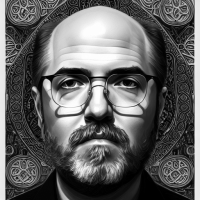Childhood’s End: Matthew Graham Interview
Writer/Executive Producer Matthew Graham talks about how he was able to bring Childhood’s End to the small screen.
In the library of masterworks of science fiction, Arthur C. Clarke’s Childhood’s End resides in a place of honor on the bookshelf. Matthew Graham, the writer and executive producer of Syfy’s upcoming miniseries based on the novel, had a daunting task adapting the epic tale for the screen. Den of Geek sat down with the British screenwriter (best known for co-creating the critically-acclaimed Life on Mars) to talk to him about this exciting project.
The miniseries format was perhaps the most helpful in accommodating the massive time scale of the novel, with the story being aired in two hour installments over three nights. This may explain why Clarke’s 1953 work has never been adapted for the screen. “I suspect that a lot of people tried it in movie form and found the movie model too restrictive,” Graham noted. “Now we’re in a sort of golden age of television where people I think are happy to invest time and attention on characters. They can take a sort of slower burn and a slower build.”
With this in mind, Graham broke the miniseries down as if it were three movies with common threads uniting each act. “The first movie was kind of The Day the Earth Stood Still,” said Graham, adding that that movie was no doubt inspired in part by Childhood’s End. “And then I felt the second episode was a little bit more like a horror movie, a bit more sort of Rosemary’s Baby… Then the third episode, not to give any spoilers, has a completely different take all its own that’s very epic, very emotional, very powerful.”
Another contributing factor to telling a story that takes place worldwide is having an environment that can communicate what Graham referred to as a “diversity of landscapes.” Because Childhood’s End was filmed in Australia, director Nick Hurran (Doctor Who, Sherlock), according to Graham, was “able to film in desert and make it look like South Africa; we built a ranch and made it look like Missouri; we filmed in cities and made it look like New York or Washington, D.C.”
The story of Childhood’s End encourages viewers to think how they might act if aliens came to Earth promising an end to war and disease but perhaps also to free will and religion. Graham suggested that “it’s very much about learning to accept that we’re finite beings, and that we are very, very small in a very big universe. And we cannot hang onto things.” The Overlords, as the aliens are called, force humanity to ask themselves, in the words of Graham, “Have they replaced God with their power, and if they have then does that make them evil or are they the new gods?”
“That was the biggest challenge,” Graham admitted with regard to the religious implications of the alien occupation. “I had to create a new character, Peretta Jones [played by Yael Stone of Orange Is the New Black], who’s not in the book, who represents religious faith, and explore that a little bit more in how we see the Overlords.”
The key, Graham said, was to tell the story of a Utopia with all of its positive aspects and its negative consequences “through personal points of view of the characters rather than to try and go around the world showing armies laying their weapons down and rather than showing people sort of leaving churches en masse all over the world.” Graham added, “I felt that would all seem a little bit… like a PowerPoint presentation.”
In the end, it seemed as though Graham was able to adapt this story for the screen by thinking like an Overlord. “Yes, there will be pockets of resistance,” Graham confessed, speaking of the hypothetical Utopia suggested in Childhood’s End. “But mostly people are just like children, they just kind of do what they’re told.”
To decide for yourself, tune into Childhood’s End as it airs from 8pm-10pm ET on Monday, December 14 through Wednesday, December 16 on Syfy. For the full Matthew Graham interview, check out the podcast below.
Listen and Subscribe on Golden Spiral Media | iTunes | Stitcher
